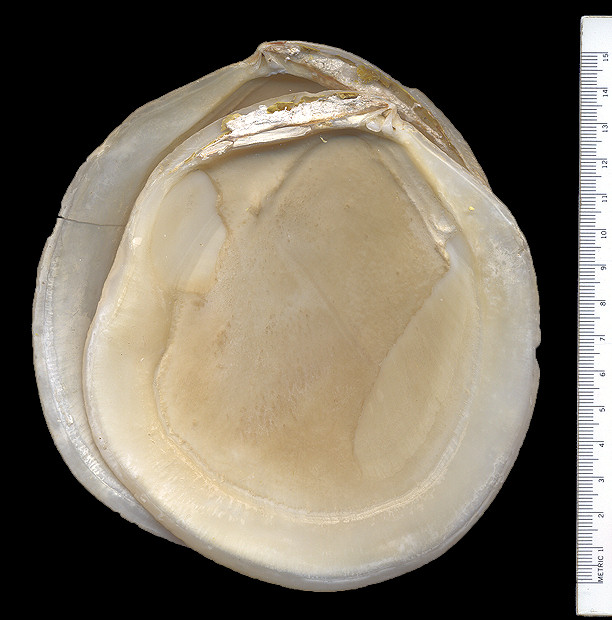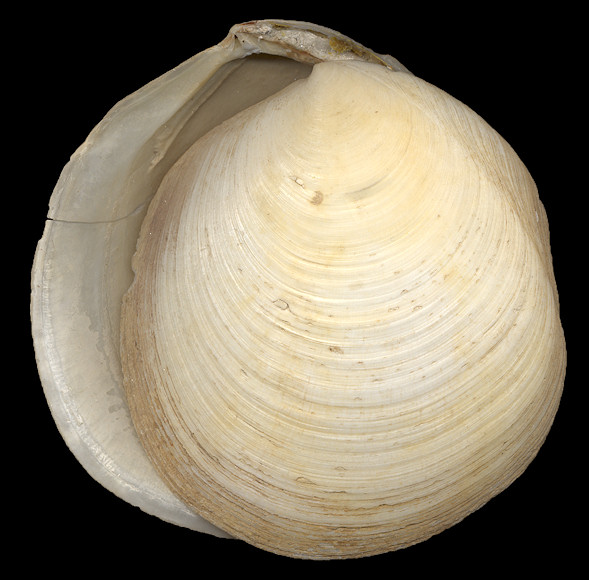|
Miltha childreni (Gray, 1824) Anna Children's Lucine |
|
|
|
|
|
From off Alcobaça, Bahia, Brazil alive at 20-25 meters. A. Bodart! September, 2002 |
|
Miltha childreni (Gray, 1824: 221) Anna Children's Lucine |
|
by Harry G. Lee This species is the type of Miltha H. and A. Adams (April, 1857: 468) by monotypy, which genus, in turn, is the type of Milthinae Chavan in Moore (1969: 501). This specimen weighs 14.6 oz and measures 146.2 mm making the species the largest of the Lucinoidea in the Atlantic Ocean and third largest in the world, the Panamic Codakia distinguenda (Tryon, 1872) and Taiwanese Meganodontia acetabulum Bouchet and von Cosel, 2004 edging it out at 152.0 mm (Pisor, 2008: 180) and "up to 150 mm" respectively.* Despite its leviathan proportions, M. childreni is seldom treated in popular shell books and is extremely rare in collections - quite likely due to its apparent scarcity in nature (Rios, 1994: 254; 2009: 516; M. Coltro, personal communication, 14 January, 2011). Of further interest is a tendency in the literature (eg. Rios, 2009: 516) and the Internet (90 vs. 311) to render the species epithet "childrenae," the feminine rather than the masculine genitive case. Since by far the famous malacologist of that surname, John George Children (1777-1852: <http://en.wikipedia.org/wiki/John_George_Children>), was also the author's boss at the British Museum (Natural History), it seems quite a plausible alternative. To understand the actual proper nomenclatorial usage, one needs to delve into the context of the original description. John Edward Gray (1800-1875: <http://en.wikipedia.org/wiki/John_Edward_Gray>) introduced the binomen Lucina Childrinae, and the reader can confirm this at the URL provided in the bibliography below (Gray, 1824b: 221). The upper-case "C" was a once-popular convention to indicate a proper noun, or just plain noun in some instances; likewise conventional was the lack of indication as to the person the author was honoring with an eponym such as this. Notice the surname "Children" was misspelled "Childrin" in Gray's description, but that the termination was unequivocally genitive feminine. This misspelling of the surname was caught by at least one reader at some point between the original publication (June, 1824) and at the completion (Jan., 1825) of that, the first volume of the Zoological Journal in which Gray's brief description appeared. The index (Anon., 1825: 598) and errata (Anon, 1825: [603]) both indicate a deliberate change in spelling from "Childrinae" to "Childreni." Here note the correction of the misspelled surname but alteration of the genitive termination from feminine to masculine. It is of more than passing relevance that John Children was one of the four principals of the Journal and neither his daughter, Anna (1799-1871; <http://en.wikipedia.org/wiki/Anna_Atkins>), nor his employee, John Edward Gray, both in their mid-twenties, shared that exalted position. The rules of taxonomic nomenclature (ICZN, 1999: Article 32) mandate that the original spelling of a species epithet such as this must stand unless there is evidence in the published work itself that the author's intention was inconsistent with that orthography. Well, there is a bit of a twist here: Article 33.2.1 specifically includes "an author's (or publisher's) corrigenda" as part of the original work. Thus, the passage of six months notwithstanding, the "justifiably emended" scientific name that heads this report must stand: Miltha childreni. As suggested in the next paragraph, sufficient grounds for invocation of Article 33.3.1 (prevailing usage of the subsequent "childrenae" spelling) cannot be mustered. The next month, February, Gray gave a more elaborate description of this species and called it Lucina Childrenae (Gray, 1825: 136)!** Thus it appeared that Gray was really naming the lucine for a lady. During the years following the introduction of this name there was considerable controversy, mostly tacit, over the eponym as summarized by Wilkins (1953: 158-160). The most poignant insight the latter author provided was: "It is pleasant to pause here to note that even at this early date J.E. Gray had already developed his propensity for naming shells after the ladies of his acquaintance, such names as Georginae, Sophae, and Emmae falling easily from his pen, and there is no doubt that he intended the name of this new species as a compliment to the daughter of his friend [John Children], a kindred spirit, who was said by the author to have "well-selected cabinet" of her own (Zool. J., 1, p. 144) [referring to Gray, 1824a; vide infra]." Thus it seems very likely that John Edward Gray meant what he wrote! Too bad he never fully explained himself in print, but that kind of mystery is what makes conchological forensics so interesting! Today we can try to redress the unjust expropriation of Anna Children's eponym by coining a vernacular name in her honor: "Anna Children's Lucine" while still rendering unto the Commission what is theirs: Miltha childreni!
* These shells shrink by comparison to Lucina megameris
Dall, 1901, reaching 310 mm (Taylor and Glover, 2009) and 318 mm
(Taylor, pers. comm. in Cosel and Bouchet 2008: 205) but
extinct for about 34,000,000 years. It is the type of Superlucina,
which genus was erected by the former authors. It was said by
them to resemble M. childreni and may be ancestral. Adams, H. and A. Adams, 1853-1858. The
genera of Recent Mollusca arranged according to their organization.
John van Voorst, London. [published in 35 parts comprising 3
volumes]: <http://www.biodiversitylibrary.org/bibliography/4772>
Anon., 1825. Index and errata.
The Zoological Journal 1: [593]-[603]. January. Bouchet, P. and R. von Cosel, 2004. The world's largest lucinid is an undescribed species from Taiwan (Mollusca: Bivalvia). Zoological Studies 43(4): 704-711. <http://zoolstud.sinica.edu.tw/Journals/43.4/704.pdf>
Chavan, A., 1969. Superfamily Lucinacea (pp. 491-517) in
Moore, R.C. (ed.), 1969. Treatise on Invertebrate Paleontology
Part N. Mollusca 6. Bivalvia. Vols. 1 and 2. Geological Society Cosel, R. and P. Bouchet 2008, Tropical deep-water lucinids (Mollusca: Bivalvia) from the Indo-Pacific essentially unknown, but diverse and occasionally gigantic. in Heros, V., R.H. Cowie, and P. Bouchet (eds.) Tropical deep-sea benthos vol. 25. Mémoires du Muséum National d'Histoire Naturelle 196: 115-213. Gray, J.E., 1824a. Monograph of the Cypraeidae, a family of testaceous Mollusca. The Zoological Journal 1(2): 137-152. June. <http://www.biodiversitylibrary.org/item/88099#page/176/mode/1up> Gray, J.E., 1824b. Conchological Observations, being an attempt to fix the study of conchology on a firm basis. The Zoological Journal 1(2): 204-223. June. <http://www.biodiversitylibrary.org/item/88099#page/253/mode/1up> Gray, J.E., 1825. A List and Description of some Species of Shells not taken Notice of by Lamarck. Annals of Philosophy New (2nd) Series 9: 133-140. February. <http://www.biodiversitylibrary.org/item/53938#page/150/mode/1up> ICZN (International Commission for Zoological Nomenclature), 1999. International code of zoological nomenclature fourth edition. International Trust for Zoological Nomenclature, London. Pp. 1-306 + i-xxix. < http://www.nhm.ac.uk/hosted-sites/iczn/code/index.jsp> Pisor, D.L. [edited by D.L. Pisor and G.T. Poppe], 2008. Registry of world record size shells Fifth edition. Pisor Marine Enterprise, San Diego, CA and Conchbooks, Hackenheim, Germany. 1-[208]. March. Rios, E.C., 1994. Seashells of Brasil 2a edição. Fundação Cidade do Rio Grande, Rio Grande do Sul, Brasil, pp. 1-368 + 113 pls. Rios, E.C., 2009. Compendium of Brazilian Sea Shells. Universidade Federal do Rio Grande, and Museu Oceanográfico Prof. Eliézer de Carvalho Rios. Rio Grande, RS. Pp 1-668; numerous text figures, most in color. Taylor, J.D. and E.A.Glover, 2009. A giant lucinid bivalve from the Eocene of Jamaica - systematics, life habits and chemosymbiosis (Mollusca: Bivalvia: Lucinidae). Paleontology 51(2): 95-109. January.
Wilkins, G.L., 1957. The Cracherode shell collection. Bulletin of
the British Museum (Natural History) (Historical Series) 1(4):
121-184, pls. 20-25. Adobe PDF file at <http://www.archive.org/details/bulletinofbritis01histlond> |

